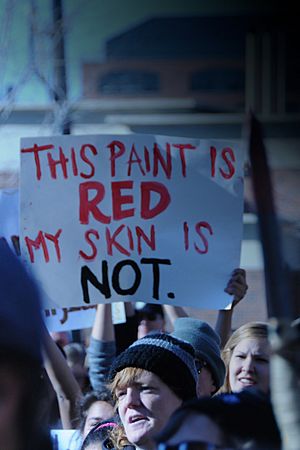Dodging Bullets—Stories from Survivors of Historical Trauma facts for kids
Quick facts for kids Dodging Bullets—Stories from Survivors of Historical Trauma |
|
|---|---|
 |
|
| Directed by | Kathy Broere, Sarah Edstrom, Jonathan Thunder (Tall Paul Segment), Bob Trench |
| Produced by | Larry Long |
| Music by | Keith Secola, Tall Paul, Dorene Day Waubanewquay, Karlee Fellner, Mitch Walking Elk |
| Cinematography | Bob Trench, Matt Myers |
| Running time | 94 minutes |
| Country | United States |
| Language | English, Dakota |
Dodging Bullets—Stories from Survivors of Historical Trauma is a documentary film. It explores how big, difficult events from the past, called historical trauma, still affect Indigenous people in North America today. The film was co-directed by Kathy Broere, Sarah Edstrom, Jonathan Thunder, and Bob Trench. Larry Long produced it, and Keith Secola created some of the music.
The movie shows how past events have deeply impacted Native American communities. It also highlights how these communities are finding ways to heal. The film premiered at the Minneapolis–Saint Paul International Film Festival. There, it won "Best of Fest." It also received the Samuel Sprynczynatyk Storyteller Award for Best Documentary Feature. This was at the North Dakota Human Rights Film Festival. The film was shot across the lands of the Plains Indians. These lands are now parts of Wisconsin, Minnesota, the Dakotas, Nebraska, Colorado, and Montana.
Contents
What the Film is About
The film's title, "Dodging Bullets," comes from American Indian Movement (AIM) co-founder Dennis Banks. He said that Native Americans have been "dodging bullets for generations." This means they have faced many challenges, not just from guns. They have also faced harm and loss of culture since Europeans first arrived.
This movie shares stories from different generations of Indigenous people. It also features researchers and politicians. They explain why Native American communities often face more health and social issues. The film calls these issues part of "Historical Trauma." It shows how resilient Native American people are still finding ways to overcome these challenges.
"Dodging Bullets" is not a typical sad story about Native American life. Instead, it gives an accurate look at life for Indigenous people. It explores current issues like poverty, racism, and mental health. It connects these issues to events from the past. The film also shows a positive path forward. This path involves healing through traditional ceremonies and strong cultural identity.
A Message from the Co-director
Kathy Broere (Blackfeet), one of the film's directors, shared an important message. She said, "Stories of Survival from Historical Trauma will help us to heal." She added that connections to culture, traditions, and family are key. These connections help people not only survive but also thrive now and in the future.
People in the Film
The film features many important voices. These include leaders, artists, and experts. They share their experiences and knowledge. Some of the people you will see are:
- Rick McArthur from AIM Legal Resources
- Dr. Rachel Yehuda, an expert on traumatic stress
- Winona LaDuke, Program Director for Honor the Earth
- Dr. Melissa Walls, a research sociologist
- Tall Paul, an Anishinaabe hip-hop artist
- Keith Secola, an Ojibwe musician
- Jesse Ventura, a former Governor of Minnesota
- Clyde Bellecourt, a co-founder of the American Indian Movement
- Tara Houska, a tribal attorney
- Dr. Anton Treuer, a professor of Ojibwe
Film Sections
The film is divided into several parts, each focusing on a different aspect of historical trauma and resilience.
Introduction
The film starts with a young girl sharing a personal story of loss. This story helps introduce the idea of historical trauma. It shows how past events can affect people's lives every day.
First Contact
This part of the film looks at the very beginning of European arrival in the Americas. It discusses how Christopher Columbus and his crew began to dominate Indigenous peoples.
No Honor in Racism
This segment explores how certain names and images used by non-Native groups can be harmful. It shows protests against the former name of the NFL's Washington Football team. It explains how using Native American names and images by others creates racial injustice.
Boarding School Era
This section discusses a difficult time in history. The US and Canadian governments tried to force Indigenous peoples to give up their cultures. They did this through religious boarding schools and residential schools. The film shows how these schools aimed to erase Native American traditions.
Treaty Rights
This part follows a father and son, Leonard and Todd Thompson. They try to gather wild rice without a permit, believing in their treaty rights. The film explains how the 1855 Treaty with the Chippewa Indians allowed tribes to keep rights to hunt, fish, and gather on certain lands.
Social Justice
This segment looks at why some health problems are more common in Native American communities. It also explores the relationship between law enforcement and Native Americans. It shows how past traumas can affect health and legal issues for Indigenous peoples today.
Loss and Resilience
The final part of the film focuses on survival and strength. It tells stories of those who have faced loss but have shown great resilience. It features Dirk Whitebreast, a Meskwaki distance runner. He was recognized for his achievements in 2018.
Awards
Dodging Bullets has received several awards:
- In 2018, the Minneapolis-St. Paul International Film Festival chose Dodging Bullets as the winner of the Minnesota Made Documentary Feature Competition. They also named it one of the "Best of Fest" films.
- In 2018, the North Dakota Human Rights Film Festival gave Dodging Bullets the Samuel Sprynczynatyk Storyteller Award for Best Documentary Feature.
- In 2019, the Bigfork International Film Festival awarded Dodging Bullets the Best Documentary award.
- In 2019, the Covellite International Film Festival recognized Dodging Bullets for Best Cinematography in a Documentary Film.
- In 2019, the Queen City Film Festival gave Dodging Bullets the Audience Award Feature.

